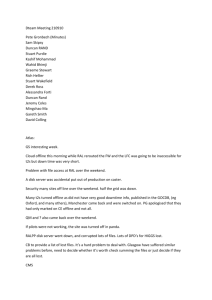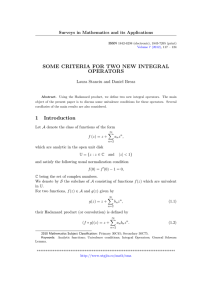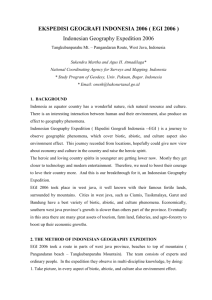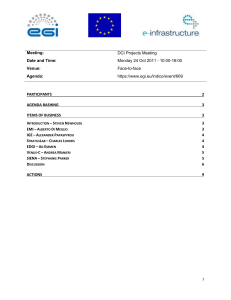A Case Study of the Roosevelt Hot Springs Geothermal Field, Utah
advertisement
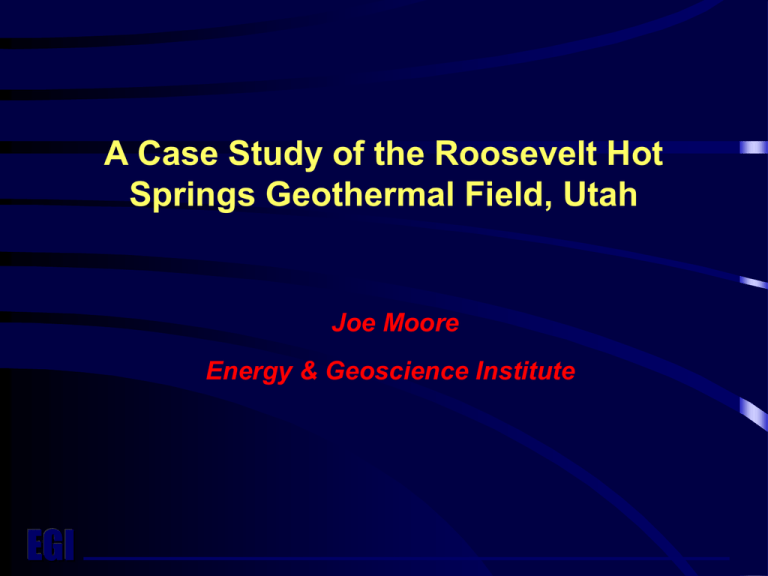
A Case Study of the Roosevelt Hot Springs Geothermal Field, Utah Joe Moore Energy & Geoscience Institute EGI Outline of Case Study • Regional Geologic Setting • Overview of early history and development • Results of geologic, geochemical and geophysical exploration studies • Evaluation of the data for exploration EGI Location of Roosevelt Hot Springs (RV) Cyan: > 3.0 Ra Yellow: 2 – 3 Ra Red : 1 – 2 Ra Orange: 0.6 – 1 Ra Green: 0. 3 – 0. 6 Ra Blue: < 0.3 Ra EGI HEAT SOURCE Circles and Squares: Magmatic Triangles: Extensional Diamonds: not sure Mantle Helium Evidence (Kennedy and van Soest, 2005) CHS Quaternary Volcanic Activity Geothermal Systems CF-S: Cove Fort-Sulphurdale CHS: Crater Hot Springs RHS: Roosevelt Hot Springs T: Thermo CF-S RHS EGI T QR Pink: Mountain Ranges Purple: Dominantly basalt QR: Quaternary rhyolite Aerial View of Roosevelt Hot Springs Geothermal Field RHS Negro Mag Fault (E-W) Opal Mound Rhyolite EGI Opal Mound EGI View of Mineral Mountains EGI View Looking to the West EGI Early History and Development (exerpted from R. Forrest, GRC Guidebook 7, 1980) • 1880’s: hot springs were discovered and named McKeans • 1900’s: a resort was established (operated by Negro Mag) • 1908: Lee identifed water type as Na-SO4-Cl with flows of 10 gpm at 190oF • 1950: flow decreased to 1 gpm; temperature to 185oF • 1966: Mundorff (1970) reported flows had ceased • 1967: McDonald and Davie drill 80 ft well at the Opal Mound 4 km south of the old resort and encountered boiling water. A second hole was drilled to 165 ft and encountered water that flashed to steam. Well plugged and reentered in 1968. Drilled to 270 ft, encountered water at 270oF; after 2 months plugged and abandoned. EGI Early History and Development (cont.) • 1968-1971: MaDonald applied for geothermal rights and mineral leases; designated a KGRA in 1971. • 1972: Thermal Power Company formed by Davie. Scientific studies at the U. of Utah initiated (most published 1975-early 80s) • 1973: Temperature gradient wells drilled. • 1974: Competitive lease sale. Phillips Petroleum Company obtains 18871 acres • 1975-1979: Productive wells are drilled near the Opal Mound and old resort in 1976 and flow testing begins. Production wells range from 1200-7300 ft depth with T max. of 268oC. Phillips, Thermal Power, O’Brian, Amax agree to develop field With Phillips Petroleum as operator. 6 of the 11 wells in the unit are commercial. Geoscientific data are placed in the public domain (1977-1979) through the US Dept. of Energy’s Industry Coupled Program. Production estimated at 120 MWe. EGI Early History and Development (cont.) • 1980: Phillips Petroleum and Utah Power and Light enter negotiations to develop field. • 1981: 1.6 MWe turbine installed and tested. • 1984: Full production begins with a 23.5 MW (26 Mw gross) plant. • 2007: A bottoming cycle will be added, providing an additional 11 MWe EGI Geological Methods • Photogeology (low sun angle, b/w, high sun angle, stereo color, multispectral infrared) • Reconnaissance mapping • Structural mapping • Volcanic stratigraphy, paelomagnetism, magma thermodynamic modeling EGI Geochemical Methods • • • • • • • • Analysis of surficial deposits Analysis of subsurface alteration Chemical and Isotopic analyses of waters Trace element surveys of soils and well samples Gamma-ray spectrometry Assessment of exothermic reactions to heat flow Geothermometry and analysis of water-rock interactions Chemistry of volcanic rocks EGI Geophysical Methods • • • • • • • • • • • • • Gravity survey Precise leveling Magnetic survey Aeromagnetic survey Resistivity (Schlumberger, Dipole-dipole) surveys Induced polarization survey Mise-a-la-masse resistivity surveys AMT/MT survey Electromagnetic sounding Self-potential orientation surveys Earthquake monitoring Refraction seismic survey Thermal gradients and heat flow EGI Geologic Studies: Lineament Map P = Photo interpretation G = Geologic observation R = Resistivity survey M = Aeromagnetic survey EGI (Ward et al., 1978) Reconnaissance Mapping EGI (Ward et al., 1978) Bailey Ridge Rhyolite Flow EGI Ts/Tpg Detailed Structural Map PCg PCbg Trf EGI Sibbett and Nielson (1980) Highly Fractured Granitic Rocks EGI Comparison of Geologic Cross Sections Based on Reconnaissance and Detailed Mapping EGI Regional Groundwater Geochemistry EGI Fluid Chemistry EGI Percent Groundwater Mixing EGI (Capuano and Cole, 1982) Trace Element Distributions EGI Hg Concentrations at Depth EGI Terrain Corrected Bouguer Gravity Map EGI (Carter and Cook, 1978) Gravity Model EGI (Ward et al., 1978) Density contrast 0.5 g/cm3 Total Aeromagnetic Intensity Residual Map EGI (Ward et al., 1978) Earthquake Epicenter Locations EGI (Ward et al., 1978) Structural Interpretation of Vibroseis Profile EGI (Ross et al., 1982) Dipole-Dipole Survey: Interpreted Resistivity Sections Depth interval: 100-150 m EGI (Ross et al., 1982) Magnetotelluric Profile EGI (Wannamaker et al., 1980) Heat Flow Map (mW/m2) Thermal characteristics based on measurements in 53 wells Most less than 110 m Gradients range from 6 to 3330oC/km (Great Basin average 35-40C/km) EGI (Wilson and Chapman, 1980) Conclusions • A very suite of geologic, geochemical and geophysical measurements were collected at Roosevelt Hot Springs during the 1970s and 1980s. • The Opal Mound Fault appears to form the western boundary of the productive reservoir. • Aeromagnetic and seismic reflection and refraction surveys were of little using in delineating the prospect. EGI Conclusions • MT investigations hold significant promise but interpretational problems have to be overcome. • Studies of particular value include: – Detailed structural mapping – Geochemical interpretations – Thermal gradient measurement (100-200 m holes) – Dipole-dipole surveys – Alteration studies of cores and cuttings EGI

